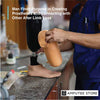New Electrode With Silicone Patch Can Improve VR, Prosthetics
Reading Time: 3 minutes
Editor’s note: In a previous post, we wrote about the potential of virtual reality in relieving phantom limb pain. One of the factors for its success is haptic feedback through a controller. With this innovation, future virtual reality training might do away with controllers and deliver pronounced vibrations directly to the skin.
Researchers from the University of California San Diego have made a significant advancement in haptic technology. They developed an electrode with a silicone patch that is more comfortable to use than existing technology. This breakthrough could enhance virtual reality, prosthetics, and wearable technologies by providing users with a more immersive experience.
![]()
The silicone patch electrode represents a departure from traditional methods by introducing a soft, stretchable electrode connected to a silicone patch. This design offers improved comfort and flexibility in simulating touch sensations on the skin.
The new design
The device consists of a soft, flexible electrode connected to a silicone patch that can be worn like a sticker on the skin. Its flexibility allows it to stretch and conform to the body’s movements while ensuring targeted and consistent current delivery.
This presents a departure from existing haptic technologies, which use rigid metal electrodes, causing discomfort or pain to the user.
The device then sends a mild electrical current through the skin, replicating various touch sensations, from subtle pressure to distinct vibrations. The electrical signal frequency determines whether the user feels vibration or pressure.
The device is made from a unique combination of two polymers, PEDOT: PSS and PPEGMEA, to achieve conductivity and flexibility.
Findings
Researchers conducted tests with 10 participants wearing the device on their forearms. They collaborated with behavioral scientists and psychologists from the University of Amsterdam, and they were able to identify the optimal electrical current levels and frequencies to elicit different touch sensations, such as pressure and vibration.
The study revealed that increasing the frequency resulted in participants feeling more vibration than pressure. Abdulhameed Abdal, one of the study's co-first authors, noted that this finding is fascinating as the biophysical understanding of how the skin perceives current was previously unknown.
These findings could contribute to the development of advanced haptic devices with applications in prosthetic devices, wearable technology, and virtual reality. This could offer more immersive experiences and improved interactions with devices.
In virtual reality, haptic feedback can enhance the immersive experience by enabling users to feel objects in the virtual world. For prosthetics, haptic devices may assist users in regaining some of their lost sense of touch. Moreover, in wearable technology, haptic feedback can introduce a new way to interact with devices.
While this innovation has huge potential, the researchers noted that further and more extensive research is still needed.










































































